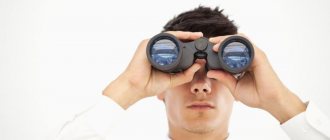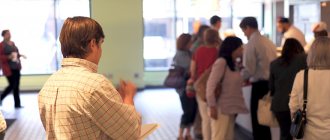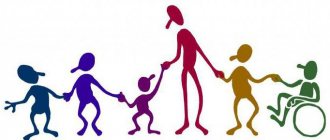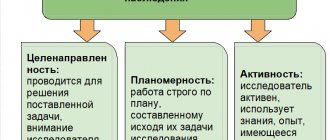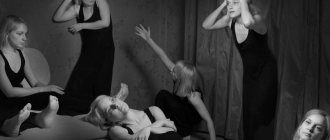About observation in general
Observation is the purposeful study and recording of the behavior of an object. The observer must create the conditions for the process, but they should in no way interfere with life.
Observation differs from passive contemplation of reality, since it has a specific goal, is carried out according to a pre-drawn plan and has special substantive means that allow not only recording the results, but also maintaining the situation at the required level.
We can say that observation is an active form of sensory cognition. With its help, you can accumulate empirical information, form initial ideas, or test pre-made assumptions regarding the object of study. It is believed that this method became the first scientific method of psychological research; during the development of science, several specific types of observation were formed.
Forms of observation
Observation is a method of collecting primary information by passively recording certain processes, human actions, events that can be detected by the senses (that is, the method is based on visual and auditory perception of phenomena).
Ordinary observation is an involuntary human activity associated with obtaining information about the world, a way of understanding the world (for philosophers, observation is the first stage of the cognitive process: from perception and observation to description, assumption, its justification and verification).
Scientific observation differs from ordinary observation in its focus (the intention to obtain certain information for given research purposes), systematicity, planning and the presence of control procedures. However, the term “observation” is not yet clearly defined. In some social sciences (sociology, statistics, demography), observation refers to any field research procedure (including survey), that is, any procedure that does not involve obtaining data from secondary sources.
Depending on the nature of the environment.
Field observation is carried out in natural conditions, in a real situation.
Laboratory observation - it is carried out in artificially created conditions and allows you to maintain the stability of the environment in which the research takes place.
Laboratory-field observation - carried out in natural conditions, but with certain restrictions that eliminate the shortcomings of both laboratory and field observation.
The researcher’s place in the process being studied (polar forms are indicated, but in practice transitional options can be used).
Observations with the direct participation of the researcher (participant observation) - the observer himself participates in the situation, he simultaneously influences the situation and, in turn, is subject to its influence. This form allows you to correct the objectivity of the observer’s conclusions due to a better understanding of the observed processes.
Observation is carried out by an observer from the outside, without participation in the observed process (non-involved observation) - the observer is located at some distance from the observed object, which allows him to see the entire process and control the external factors influencing it.
According to the nature of perception of the object of observation.
Personal observation - observed events are recorded directly by the observer.
According to the degree of standardization of observation.
Non-personal observation - observed events are recorded using devices that reduce the subjectivity of the perception of events. Structured (controlled) observation - in this case, observation sheets are used with a clearly defined structure of recorded elements (aspects) of a process or situation, other elements of behavior are ignored.
Free (unstructured) observation - all elements of behavior are observed without a predetermined pattern.
Overt surveillance—observers know that surveillance is taking place and researchers warn them in advance.
Covert observation - those being observed do not know about the research being conducted.
According to the regularity of observation.
Systematic observation is carried out regularly and allows you to identify trends in processes.
Episodic observation does not have strictly defined rules for recording events.
Observation in one case - observation is carried out once in accordance with established goals, this observation scheme is not used again.
Random observation - observation of an unplanned phenomenon is usually not planned as a separate method of collecting primary data. Meanwhile, this often becomes a one-time reason for revising the marketing decisions of an enterprise.
Three meanings
Typically, observation is viewed from three different angles. Depending on the situation and scope of use, there are:
- Observation as a method.
- Like an activity.
- Like a technique.
Observation can be a scientific method, then it will include a system of principles of knowledge, provisions on essence and the specifics of psychological observation about the possibilities of human activity. This option is considered universal and is used to study a wide range of phenomena. The observation method is quite flexible, and if the need arises, the researcher can change the “field of coverage”, put forward and test additional hypotheses during the experiment. In addition, such activities require minimal hardware. The specificity also lies in the attitude towards the object being studied: the researcher does not interfere in his life, but at the same time maintains visual and auditory contact.
Observation as an activity is used in some practical areas. For example, an energy systems operator monitors instrument readings, a doctor examines patients, an investigator monitors a criminal, etc.
On the third hand, there is also an observation technique. It is a socially fixed subject system for collecting and processing data, which is presented in a language understandable to others and corresponds to previously identified tasks.
Observation units, their registration
Units of observation are simple or complex actions of the object of study that are accessible to the observer. To register them, special documents are used:
1. Observation card. It is necessary to register certain characteristics in a formalized and often coded form. As the study progresses, several of these cards can be used, separately for each unit of study.
2. Observation protocol. Designed to record combined results in formalized and informal procedures. It reflects the interaction of observation cards.
3. Observation diary. Psychology often uses various observation logs. They are necessary in order to record the results of the study. They indicate not only various information about the object itself, but also the actions of the observer committed during the study.
When recording the results, various film and video equipment can also be used.
Features of the method
Various types of observation have been widely used since the end of the 19th century in those areas where the behavior of a person caught in various situations was of particular importance. Observation was and is used in cases where the researcher cannot or is not allowed to interfere with the natural course of the life process.
Observation is considered an indispensable source of information if a psychologist needs to create a holistic picture of what is happening and display the behavior of each participant in its entirety. The main features of the method include the following characteristics:
- Direct connection between the researcher and the object of observation.
- The emotional component of the experiment.
- It is difficult or impossible to conduct a similar experiment again.
In the natural sciences, the researcher usually does not influence the phenomenon being studied. On the other hand, in psychology there is a problem of interaction between the scientist and the subject. If a person knows that he is being monitored, this can significantly affect his behavior. Therefore, in order to minimize such an impact, the observer needs to “become familiar” to the subject or justify his presence with some reason that does not focus attention on the person.
The essence of the method
Observation in psychological science, unlike everyday observation, is based on a specific plan, a program thought out in advance, and requires recording facts, their analysis and interpretation.
Only external (speech, motor) manifestations are available for tracking. For example, it is impossible to observe:
- intelligence, but the researcher can monitor the process of solving problems;
- sociability, but you can see the fact of communication with other people.
Observed situations, phenomena, and behavior of objects are necessarily recorded in protocols and diaries. The observed characteristics are presented as descriptively as possible, without explanation. The form of the protocol reflects the subject, task, hypothesis and main criteria of the study.
The reliability of observation results increases if the researcher has the opportunity to use the method for a long time, to observe objects in different situations and roles. The reliability of the study also increases if several observers monitor the situation.
Qualitative observation is only possible if there are no role relationships between object and subject. For example, a schoolchild behaves differently in the presence of parents, teachers and friends. Therefore, the characteristics that different people give it differ.
Psychological observation does not allow the subject to intervene in the situation being studied. The observation results are necessarily supported by data from other research methods.
Types of surveillance
Typically, the type of observation is determined by the goals, object and situation of the study. Thus, it is customary to distinguish:
- Objective observation and self-observation.
- Field and laboratory research.
- Individual and collective experiment.
- Random and intentional learning.
- Systematic and non-systematic observation.
- Complete and incomplete research.
- Complete and selective experiment.
- Ascertaining and evaluative learning.
- Standardized and non-standardized observation.
- Open and closed research.
- Included and unincluded experiment.
- Direct and indirect research.
Thus, we see that there are 12 pairs of forms, types and methods of observation. Let's look at them separately.
Accepted classification
Observation is usually used when it is impermissible or simply impossible to interfere with the natural course of an event. It is divided into several types:
- external and internal;
- direct and indirect;
- direct and indirect;
- included and not included;
- field and laboratory;
- continuous and selective.
There are also different types of observation depending on the systematicity, form, objects recorded, and awareness. In the first case, there are non-systematic and systematic studies. The latter are carried out according to a specific plan, and during the experiment a person records the characteristics of the subject’s behavior and creates a classification of environmental conditions. Non-systematic ones allow you to create a general picture of a phenomenon under certain conditions. Typically such studies are field studies.
Observation is contrasted with experiments according to two criteria: spontaneity and passivity of the researcher. He cannot interfere in the course of the process, but he must write down what he sees in the protocol.
Based on the recorded objects, continuous and selective observations are divided. With the first, a person tries to note down all the features of behavior. And with the second, it records only certain acts or parameters. Depending on the forms of behavior, several studies are distinguished: conscious, unconscious external and internal, the surrounding world.
With awareness, the subject knows that he is being observed. That is, the researcher contacts him, tells him in advance about the task of the experiment and his social status. But sometimes he is given incorrect information in order to monitor his behavior in a certain situation. Although such actions lead to ethical problems and negative results.
This method is used only if it is due to observation requirements. It is necessary to conduct several studies, since the actions of the subject depend on the influence of the scientist, and if the task is incorrectly stated, the results will not meet expectations. The observation situation can be stressful for the subject, and the results will negatively affect his life.
Unconscious inner
Unconscious internal observation is different, because with it the subject does not know anything about the study. The one who conducts the assessment becomes part of the system. For example, a psychologist can infiltrate a group of representatives of a subculture to study behavior in detail. The observer is in close contact with the subjects, but they have no idea of his purpose.
This method is used to study the social characteristics of small groups. The observer must behave naturally, then his work will not influence their actions and the conclusions of the protocol. But ethical issues can become a problem: the researcher will have to deceive the group. He will also have difficulties with recordings - the results must be recorded secretly so that no one notices.
The fact that surveillance is being conducted will not affect the subject's behavior in any way. And with direct contact, the researcher will receive more information. But this can also cause some problems: sometimes psychologists adopt the value system of the group being studied, and moral conflicts arise.
External type
The definition of external unconscious observation is that the subject is unaware of the experiment. The researcher does not have contact with the group; he records information from the outside. For example, in psychiatric hospitals, the doctor monitors the patient through a special window. From the doctor's perspective, it is transparent, but the patient sees it like a mirror.
This organization of observation makes it possible not to embarrass subjects or provoke them to certain actions. Thanks to this, the researcher can collect objective information about the behavior or phenomenon. Another plus is that if at any stage the observer gets tired, he will be quietly replaced by another.
The naturalness of actions is not disrupted due to the pressure of the researcher; it becomes possible to use technical means of recording information. But due to limitations, it will be necessary to study the situation only from one side; it will not be possible to learn in more detail about the behavior of the subjects.
By observing the environment, we can learn more about the conditions that influence people's actions. Modeling certain situations will help to study all the factors influencing the subjects being studied.
Objective, laboratory and field research
The first type of observation method that you should pay attention to is called objective. This is the study of an object from the outside, that is, the observer looks at those objects that are external to him. This type of observation is widely used in psychology and sociology, as well as in related disciplines. This method is also called external observation.
Introspection (self-observation or internal exploration) was used in the early stages of the development of psychology. The subject independently observed himself and recorded changes in consciousness. Nowadays this method is used very rarely.
Field observation (also known as natural observation) involves the study of objects that are in their natural habitat. This type of observational method is generally considered a stand-alone method of data collection. It can be combined with other research methods if observation is the main component of the study, and all other methods are auxiliary or will take place at a different time.
Experimental or laboratory research is carried out in artificially created conditions. The degree of this artificiality can be different: minimal (when a casual conversation is being conducted) or maximum (when a person is placed in a special room and given instructions for behavior). Unlike field research, experimental observation is almost always associated with other empirical research methods.
Advantages and disadvantages
Any type of observation method in psychology has advantages and disadvantages. The advantages include the ability to capture and record acts of behavior of interest and include them in the reporting protocol. The psychologist simultaneously examines the relationships of subjects with each other and with other objects and phenomena. In some cases, even their consent or preparation will not be needed.
You can record several parameters at once - movements and physical interaction, verbal and non-verbal communication . Psychologists receive information quickly, and the method itself is quite cheap. If you do not use special recording equipment, then no costs will be required.
But observation also has its downsides. There are too many distractions and factors that interfere with research. Circumstances rarely repeat themselves, so if one phenomenon is missed, it will not be possible to draw a correct generalizing conclusion. All results must be classified according to specific parameters. Different types of surveillance will require a lot of time and effort.
Psychological research methods make it possible not to assume, but to accurately find out some information from the life of subjects. With the help of observation, one can understand the essence of an individual’s behavior, his attitude towards others and himself.
Individual, collective, accidental and intentional observation
Individual research is a type of statistical observation that is carried out by one scientist. The observer may be the only one studying the project, but may also be part of a team of scientists. In the latter case, he will study the object independently, but his work will be part of the project.
Collective research is carried out by a group of several individuals. They have a common plan of action, use the same methodology and pursue the same goal. In some cases, it is assumed that this type of observation in psychology is determined by the simultaneity of the research.
A random study is not planned in advance, but is carried out because circumstances arise. This type and method of observation is valuable in the study of rare phenomena, the occurrence of which cannot be predicted. For example, here we can talk about UFOs or sudden natural disasters. Random observations are divided into two types: everyday and professional. Every person makes everyday observations in everyday life. Professional incidental observation occurs unintentionally as a result of professional activity. In this case, the scientist is already internally ready to conduct observations and can see something interesting where an ordinary person cannot. This is how many discoveries of the past were made. Deliberate surveillance is planned and serves specific purposes.
Types of objects
Observation and experiment in psychology, as well as other methods, can have the following objects of study:
- person (or animal);
- a whole group of people.
The subject of observation can, as a rule, only be the external component of activity (movements, movements, contacts, joint actions, speech acts, facial expressions, external manifestations of vegetative reactions, as well as various situations, both spontaneous and organized).
Systematic and complete studies
Depending on the systematicity, types of observation are divided into systematic and non-systematic.
Systematic observations are carried out according to a pre-created plan and schedule. The concept of systematicity is considered here in two aspects:
- Procedural. There are clearly defined tasks and goals, and a working hypothesis is formulated. The observer's actions are determined and ordered in advance. You can also observe a well-thought-out system of recorded indicators.
- Temporary. Multiple observations are planned and balanced in advance. Simply put, a person is observed, some manifestations of character are recorded, and this procedure is repeated when his life situation changes or he reaches a certain number of years. For example, through time observation it was found that a person's character changes every seven years.
On the other hand, there are non-systematic studies that do not have a specific plan of action. The procedural aspect is manifested in the uncertainty of tasks and there is no provision for recording facts. The time aspect is expressed in conducting multiple observations randomly.
Another type of statistical observation is called complete. The main task of the researcher is to cover and record all available information about the subject of study. Typically, this method is used to better study the object of study. However, there are situations when such an approach is a necessary measure. This happens in cases where it is unknown what factors influenced a person’s behavior.
With incomplete observation, the researcher pays attention to the optimal number of factors on which certain conclusions can be drawn. Before starting an observation, the researcher makes a list of factors that need to be paid attention to, usually in order to eliminate unwanted information gaps.
Sample experiment and statement of facts
Continuous observation is permanent and is used for short-term study of an object in order to obtain more complete information about the dynamics.
The form and type of continuous observation is often confused with complete observation. However, the “complete - selective” scale characterizes temporary reality, and the “complete - incomplete” scale characterizes quantitative reality. That is, any continuous observation can be either complete or incomplete. Sample observations are usually carried out in separate time periods. The researcher determines at his own discretion.
Another type and method of statistical observation is ascertaining. Any phenomena are recorded by the researcher, but are not discussed or evaluated. As a rule, recorded facts do not require additional interpretation. For example, photographs - it is difficult to interpret the image in any other way.
Evaluative observation is a type of activity in which the researcher evaluates a situation or a fixed phenomenon. Typically, this method is used when hypotheses are made and the factors that unite the perceptual process need to be explained. Evaluative observations are generalizing and interpretive.
Full and incomplete observation
Complete - observation in which the maximum information available to the observer is recorded and recorded. Used for extremely thorough examination of an object. Often, complete observation is carried out as a coercive measure, when it is not known in advance which factors of the situation and behavior of the observed should be recorded and which are not necessary, which are considered significant and which are not important, which can be expected and which are not predictable. This situation usually accompanies a preliminary, indicative study that precedes the main cycle of research, in which the observation will already be more focused and specific, with a limited field of search. Sometimes the researcher has to resort to full observation due to poor preparation and forethought in the preliminary stages of the study - problem statement, hypothesis formulation and planning.
It is clear that the completeness of information is a relative matter, and its degree depends on the objective and subjective abilities of the observer, as well as on his understanding of “absolute” completeness. Thus, the “exhaustive” completeness of observation characterizes the methodological crudeness of a particular study rather than its “empirical richness” and the breadth of interests of the researcher.
Incomplete is an observation in which the observer’s attention is focused on the optimal (less often, minimum) number of parameters of the situation and behavior of the observed. This range of information that needs to be collected is determined in advance, based on the purposes and conditions of observation. As a rule, such regulation of the observation process does not strictly limit the actions of the observer, but only prevents unwanted gaps in the information sought.
In other words, it does not prevent the observer from going beyond the established set of questions if this turns out to be necessary or useful for the process, but only directs him to an infinite variety of monitoring situations. Thus, this limitation not only does not “tie the hands” of the observer, but, on the contrary, frees him from the previous problems of choosing what to observe and what to record. And this allows for more careful and attentive observation of the main thing (according to the research hypothesis) and increases the likelihood of discovering additional important (in the observer’s opinion) facts. This increases the reliability and accuracy of observational data. Obviously, partial surveillance is much cheaper and usually more effective than complete surveillance. This type of observation is typical for baseline and control studies.
Continuous - continuous observation of an object without interruption. It is usually used for short-term research or when it is necessary to obtain the most complete information about the dynamics of the phenomena being studied.
Sometimes continuous observation is interpreted as complete. It does not seem reasonable to mix these characteristics; it is better to adhere to a more traditional view: the “continuous - sample” parameter reflects the “temporal strategy” of the study, and the “complete - incomplete” parameter reflects the quantitative one. […] From this observation it follows that any continuous observation can be either complete or incomplete, and it is even more rational to conduct continuous observation after an incomplete one. The reverse is also true: any complete or incomplete observation can be either continuous or selective.
Sampling is observation made at discrete time intervals chosen at the discretion of the researcher. It is less expensive than continuous monitoring. This is advisable for long-term, protracted research, as well as for filling scattered gaps in knowledge about a known holistic phenomenon. Naturally, the authors consider continuous observation to be complete; selective observation is equated to incomplete. Continuous observation is observation in which the observed phenomena and activities are simply recorded and are not subject to discussion or evaluation by the researcher during the observation.
Standards. Open and closed research
Also, observations can be standardized or non-standardized. The first are carried out according to a pre-agreed scheme, which is a reference for fixing and recording parameters in a specific situation. For example, if the phenomenon being studied is clear and you only need to record some elements, researchers can use forms that are made according to a certain standard. In turn, non-standardized observation is carried out in a free form. As the researcher wants, he describes what is happening. This method makes it possible to look at an object from a different angle and allows you to see patterns that were not previously noticed.
In open observation, individuals are aware of their role as “test subjects,” and at times even know the observer. True, this method somewhat limits the field of action of the researcher. Covert research is carried out unbeknownst to the subjects and is considered more common, although it can often entail ethical difficulties.
Involved, direct, provoked
In participant observation, the researcher is part of the group being studied. So to speak, trying to understand it from the inside. Despite its many merits, this observation has a significant drawback: scientists may lose objectivity by moving from the position of scientist to the role of test subject.
It is worth noting that observations can be carried out not only by people interested in the results, but also by their representatives. When a scientist observes, it is a direct study; when an intermediary, it is an indirect study. Typically, indirect observations refer to obtaining information from witnesses to an event. For example, in law enforcement agencies, the testimony of people who have become unwitting witnesses to a crime is important.
Subject of observation
Depending on the subject of study, the researcher selects the necessary forms and types of statistical observations. Typically the objects are:
- Verbal behavior - the content, duration and intensity of speech are also taken into account.
- Nonverbal behavior - facial expressions and gestures are examined.
- Movement of people.
Simply put, objects can be any situation that can be clearly captured. The researcher is not interested in the properties of the psyche, only statistics and facts. But based on the position that the properties of the psyche are manifested in behavior, a psychologist, based on the collected facts, can build hypotheses on mental properties.
Rules for conducting observations
When conducting research, it is important to fulfill the following requirements:
- Decide in advance which type of observation will be more optimal, and draw up a research program, highlighting the most important objects and stages.
- Do not influence the natural course of events in any way.
- Observation must be repeated and systematic (especially if it concerns the study of personality).
- When studying psychic phenomena, observations must be made on different objects. Even if you need to study a person, more detailed information can be obtained by comparing him with others.
Surveillance Tools and Code of Ethics
Observation can be carried out by the researcher himself, or he can use various recording devices - voice recorders, cameras, etc. It is important to understand that observation is not an experiment, because: firstly, it does not change the surrounding reality, and secondly, the observer It records only what it sees.
In Russia, scientists can carry out observations at any time convenient for them. In America, things are not so simple. There is a code of ethics of the American Psychological Association, which allows observation, subject to certain rules, namely:
- It is necessary to obtain the consent of the participants to conduct the study. The only exceptions are observations that are carried out in public places.
- Psychologists should not cause harm to subjects, and if it cannot be avoided, reduce possible harm.
- Minimize invasion of privacy.
- Do not disclose confidential information about observation participants.
In psychology, observation is considered an indispensable source of empirical information, because only when alone or in familiar conditions does a person shed all masks, allowing emotions to take precedence over reason, thereby exposing his true essence.
Psychological observation: definition of the concept
Observation in psychology is one of the main methods of knowing the characteristics of an object empirically. The method requires a mandatory transition from describing facts to explaining their essence, forming a psychological characteristic of what is being observed.
The results of applying the scientific method can be influenced by the following factors:
- level of knowledge in the area under study;
- professional experience, qualifications of the observer;
- personal experience, emotional and mental stereotypes, value orientations of the psychologist.
Observation presupposes the non-interference of the subject in the process or situation under study.
The method makes it possible to get a complete picture of what is happening and reflect it through records and tables. A special feature of the procedure is the complexity, and often the impossibility, of accurately repeating the observation situation.

